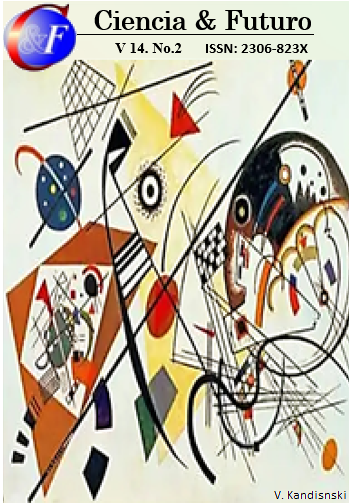Evidence of doses affecting electrical potential using a giant squid axon simulator
Keywords:
zombies, sodium channels, neurotoxin, teutids, cephalopod mollusksAbstract
Changes in the action potential of the squid giant axon were observed from different doses of tetrodotoxin using the virtual experiment simulation program Nerve. Results obtained in previous research were replicated in the squid giant axon model. Evidence was obtained about the effective doses of tetrodotoxin in the axon of the giant squid. The results indicate that the effects derived from the extracellular presence of tetrodotoxin are reflected in the graphs of the results, due to the delayed effect of the action potentials over time depending on the dose administered.Downloads
References
Anderson, W. H. (1988). Tetrodotoxin and the zombi phenomenon. Journal of ethnopharmacology, 23(1), 121-126. doi:10.1016/0378-8741(88)90122-5
Bane, V., Lehane, M., Dikshit, M., O’Riordan, A., & Furey, A. (2014). Tetrodotoxin: Chemistry, toxicity, source, distribution and detection. Toxins, 6(2), 693-755. https://www.ncbi.nlm.nih.gov/pmc/articles/PMC3942760/
Benedek, C., Rivier, L. (1989). Evidence for the presence of tetrodoxin in a powder used in Haiti for zombification. Toxicon, 27, 473-480. https://doi.org/10.1016/0041-0101(89)90210-9
Booth, W. (1988). Voodoo science: a popular claim that a chemical found in puffer fish may be a crucial element in the creation of the zombies of Haitian folklore has been challenged; critics claim contrary evidence was ignored. Science, 240(4850), 274-277. https://www.science.org/doi/abs/10.1126/science.3353722
Cole K. S. (1968). Membranes ions and impulses. Berkeley, University of California Press.
Cuervo, L. A. (1970). Equilibrium and Kinetic Properties of the Interaction between Tetrodotoxin and the Excitable Membrane of the Squid Giant Axon. The Journal of General Physiology, 55(3), 309–335. https://doi.org/10.1085/jgp.55.3.309
Davis, E. W. (1983). The ethnobiology of the Haitian zombi. Journal of ethnopharmacology, 9(1), 85-104. https://doi.org/10.1016/0378-8741(83)90029-6Get
Field-Cortazares, J., Calderón-Campos, R., & Seijo, J. L. (2009). Envenenamiento por pez globo. Boletín Clínico Hospital Infantil del Estado de Sonora, 26(1), 28-32. https://www.medigraphic.com/pdfs/bolclinhosinfson/bis-2009/bis091f.pdf
Gomes, A. P., Dos Santos, A., Ambrósio, C. E., & Ribeiro, M. O. (2011). Emprego terapêutico da tetrodotoxina em organismos animais. Acta Veterinaria Brasilica, 5(4), 343–350. https://pesquisa.bvsalud.org/portal/resource/pt/biblio-1414593
Hodgkin A, Huxley A. (1952) Quantitative description of membrane current and its application to conduction and excitation in nerve, J. Physiol, 117, 500-544.https://doi.org/10.1113/jphysiol.1952.sp004764
Inglis, D. (2010). The zombie from myth to reality: Wade Davis, academic scandal and the limits of the real. Scripted, 7, 351. https://heinonline.org/HOL/Page?handle=hein.journals/scripted7&div=35&g_sent=1&casa_token
Kotsias, B. A. (2004). El axón gigante de calamar. Medicina (Buenos Aires), 64(3), 273-276. http://www.scielo.org.ar/scielo.php?script=sci_arttext&pid=S0025-76802004000300017
Lee, C. & Ruben, P. (2008). Interaction between voltage-gated sodium channels and the neurotoxin, tetrodotoxin. Channels, 2(6), 407-412. https://doi.org/10.4161/chan.2.6.7429
Pratheepa V., Alex A., Vasconcelos M. (2016). Análisis de diversidad bacteriana y tetrodotoxinas en las vísceras de los gasterópodos de las costas portuguesas. Toxicon 19, 186-193. https://aac-europe.org/wp-content/uploads/2018/06/AAC-MACRecommendation-TTXES.pdf
Sevcik, C. (1976). Binding of tetrodotoxin to squid nerve fibers. Two kinds of receptors? The Journal of General Physiology. https://doi.org/10.1085/jgp.68.1.95
Tasaki, I. (1978). Further Studies of Periodic Miniature Responses in Squid Giant Axons. Jap. J. Physiol 28, 89–108. https://doi.org/10.2170/jjphysiol.28.89
Published
How to Cite
Issue
Section

This work is licensed under a Creative Commons Attribution-NonCommercial 4.0 International License.
Esta obra está bajo una Licencia Creative Commons Reconocimiento-NoComercial 4.0 Internacional
La Revista Ciencia & Futuro es una revista de acceso abierto, todo el contenido está disponible gratuitamente sin cargo para el usuario o su institución. Los usuarios pueden leer, descargar, copiar, distribuir, imprimir, buscar o vincular los textos completos de los artículos, o utilizarlos para cualquier otro fin lícito, sin pedir permiso previo al editor o al autor. Todo lo anterior, de acuerdo con la definición de BOAI de acceso abierto.
Los autores que publican en esta revista están de acuerdo con los siguientes términos: Licencia Creative Commons Atribución-NoComercial permite que el beneficiario de la licencia tenga el derecho de copiar, distribuir, exhibir y representar la obra y hacer obras derivadas para fines no comerciales siempre y cuando reconozca y cite la obra de la forma especificada por el autor o el licenciante. Los autores pueden establecer por separado acuerdos adicionales para la distribución no exclusiva de la versión de la obra publicada en la revista (por ejemplo, situarlo en un repositorio institucional o publicarlo en un libro), con un reconocimiento de su publicación inicial en esta revista. Se permite y se anima a los autores a difundir sus trabajos electrónicamente (por ejemplo, en repositorios institucionales o en su propio sitio web) antes y durante el proceso de envío, ya que puede dar lugar a intercambios productivos, así como a una citación más temprana y mayor de los trabajos publicados (Véase The Effect of Open Access) (en inglés). Lo anterior debe realizarse siempre sobre el artículo ya publicado por Ciencia & Futuro.
Los autores mantienen el control sobre la integridad de sus trabajos y el derecho a ser adecuadamente reconocidos y citados.
A los editores se les otorgan derechos no exclusivos para publicar y distribuir.






